Haptic Technology Market Size, Share & Industry Growth Analysis Report by Feedback Type (Tactile, Force), Component (Hardware (Actuators, Drivers & Microcontrollers) Software), Application (Consumer Devices, Automotive & Transportation, Commercial & Industrial) and Region - Global Forecast to 2028
Updated on : October 30 , 2023
The Global Haptic Technology Market Size is estimated to be worth USD 3.9 billion in 2022 and is projected to reach USD 5.0 billion by 2028, at a CAGR of 3.7% during the forecast period.
Rising integration of haptic technology into consumer devices, growing use of haptic technology in automotive industry, and increasing use of haptics in the healthcare industry are some of the major factors contributing to the haptic technology industry growth.
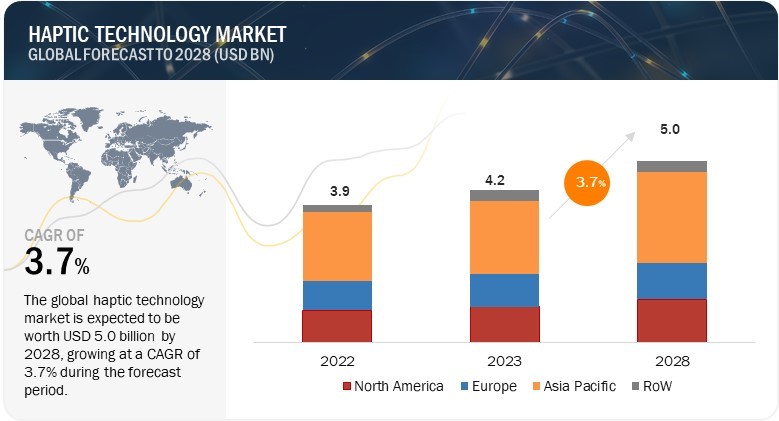
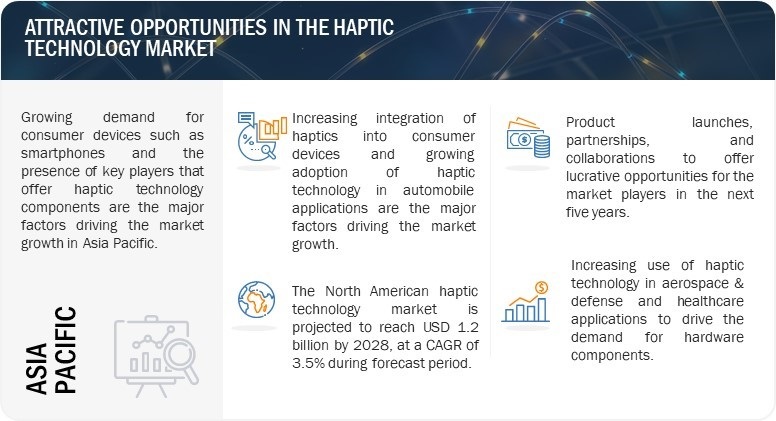
Haptic Technology Market Forecast to 2028
To know about the assumptions considered for the study, Request for Free Sample Report
Haptic Technology Market Dynamics
Driver: Rising integration of haptic technology into consumer devices
Haptics is widely used in consumer devices to enhance the sensation, performance, and overall contribution of achieving touchscreen accuracy. The growing use of consumer devices such as wearables, smartphones, tablets, smart homes, and virtual reality hardware is a major factor contributing to the market’s growth. As most consumer devices are touch-enabled appliances integrated with haptics, the demand for haptic-based solutions is expected to increase significantly in the next five years.
Haptic technology generates efficient and effective controls in a user-friendly format. Moreover, the increasing adoption of haptic technology in the gaming industry is expected to significantly contribute to market growth. For instance, Sony’s PlayStation 5 uses haptic effects in its gaming controllers to minimize the gap between human and digital interaction. Similarly, haptic technology is used in smartphones to stimulate a sense of touch through force, vibration, and motion for the end user. It delivers sensation through touch UI as it enhances the experience of conveying information from the digital to human and human to the digital world. The constantly growing use of smartphones is also a major factor contributing to the market growth.
Restraint: High cost of force feedback technology
Haptics that use tactile interfaces are majorly integrated into consumer devices and are not higher in cost than force feedback haptic devices. The major setback for the haptic technology market is the high cost of its force feedback devices used in the medical, automotive, aerospace, and manufacturing industries and supports assistive learning. Force feedback haptics requires efficient and effective devices with suitable features for running the haptic technology. They are categorized based on degrees of freedom (DoF) into 3DoF, 6DoF, and 7DoF. They allow the users to sense real-time virtual haptics while using them in various applications.
The reason behind the high cost of force feedback technology is the development costs, material costs, and patent and licensing costs. Along with that, as the demand for force feedback haptic devices is still emerging, manufacturers cannot benefit from the economies of scale. For example, haptic gloves are sensor-based, which detects hand movements and stimulates force feedback to the users’ fingers. They are used in virtual reality and gaming applications to generate the touch sense and manipulate the objects of the digital world. However, they are quite expensive to purchase.
Opportunity: Rising applications of haptic technology in aerospace & defense industry
The adoption of mid-air haptics has increased in several industries, such as aerospace & defense. It is planned to be used in simulated pilot training or virtual reality flight decks to overcome the high cost and inefficiency that most airlines face. Mid-air haptic feedback technology will allow pilots to focus on other operations like monitoring the cockpit displays and other attention-grabbing monitors, even if it means drawing away the pilot’s attention from the view out of the window. Besides, haptics also has the potential to improve the safety of the environment, quality of pilot training, and flight experience for the pilot and the passengers.
Haptic feedback can also detect situations based on immersion and intuition, allowing the pilot to understand the aircraft’s behavior and performance and implement effective and efficient decisions accordingly. Similarly, haptic technology can save time and money in the defense industry. It also enhances situational awareness, which can benefit the defense industry majorly. For instance, haptic feedback can alert the soldiers about the nearby or approaching threat, which will help them make logical decisions to protect themselves. Haptic technology using a tactile interface can also improve the accuracy and control of the weapon.
Challenge: High power consumption in haptic feedback
One of the major challenges the market players face is the high-power consumption of haptic feedback. The haptic mechanism in phones drains the battery, keeping users from gaining tactile feedback benefits. All battery power is required to run the motor, which triggers haptic feedback leading to high power consumption. This is expected to hinder the growth of haptic technology providers. Eccentric Rotating Mass (ERM) consumes a higher energy rate than Linear Resonant Actuator (LRA).
Therefore, LRA provides a better battery life to the applications. Along with that Piezo actuator generates a quick response time, which creates short effects. Therefore, this short duration contributes towards energy savings. Designing solutions that focus on haptic drivers’ implementation will regenerate and boost converter-based implementation that reduces the rate of power dissipation and maximize the battery life of the haptic-enabled portable devices.
Haptic Technology Market Trend
The haptic technology market is witnessing significant trends driven by advancements in consumer electronics, automotive, and healthcare sectors. Integration of haptic feedback in smartphones and other consumer devices enhances user experience, making it a vital component in modern gadgets. The automotive industry is also increasingly incorporating haptic technology to improve vehicle control systems, providing tactile feedback for safer and more intuitive interfaces. Additionally, the healthcare sector is adopting haptic technology for medical simulations and remote surgeries, enabling precise control and tactile feedback in critical procedures?
Haptic Technology Market Growth
The growth of the haptic technology market is fueled by the increasing deployment in various applications and the continuous advancements in technology. Consumer devices remain the largest segment, driven by the demand for enhanced user experiences in smartphones and gaming consoles. The automotive sector is rapidly adopting haptic technology for improved driver interfaces and safety systems. In healthcare, the technology's ability to provide realistic tactile feedback is revolutionizing medical training and telemedicine. These factors, combined with strategic partnerships and product innovations by leading companies, are propelling the market towards sustained growth
Haptic Technology Analysis
The Asia Pacific region is expected to dominate the market, driven by the high production of consumer electronics and automotive components. Key players like Texas Instruments, Johnson Electric, and TDK Corporation are at the forefront, leveraging advancements in microcontrollers and AI to enhance haptic solutions. The market segmentation includes hardware and software components, with applications spanning consumer devices, automotive, healthcare, and industrial sectors
Haptic Technology Market Ecosystem
The prominent players in the haptic technology market are Texas Instruments Incorporated (US), Johnson Electric Holdings Limited (China), AAC Technologies (China), TDK Corporation (Japan), and Microchip Technology Inc. (US). These companies not only boast a comprehensive product portfolio but also have a strong geographic footprint.
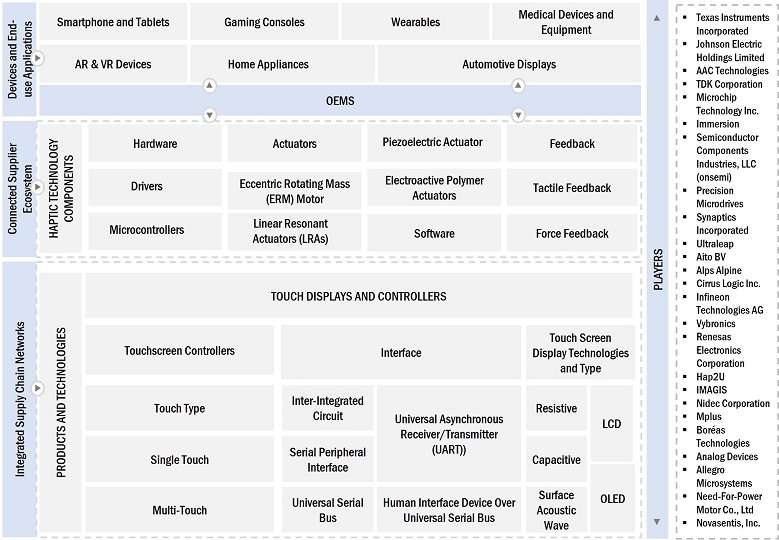
Software to register highest CAGR during forecast period
The haptics software enables users to interact with devices. It has been developed to perform specific programmed tasks on various devices. The software layer is part of the haptic system that is responsible for ensuring multimodal consistency, decoding effects, and timing/scheduling effect playback. The part of the haptic stack manages the haptic experience in real time. The software layer must create command signals for the driver IC to convert into electrical signals to control the actuator. To produce high-quality haptic experiences, it is critical that the software layer has performance-oriented functionality. With technological advancements in consumer devices and the increased adoption of haptic-enabled devices, the software market is expected to grow significantly from 2023 to 2028.
Consumer devices accounted for the largest share of haptic technology market in 2022
The consumer devices application of haptic technology includes various devices in which haptic effects are embedded, such as smartphones, tablets, gaming devices, smartwatches, cameras, media players, handheld devices, and haptics-enabled touch-based phones. Consumer electronics with haptics provide easier, intuitive access to music, multimedia, and photography. Almost all smartphones today are equipped with haptic devices. Smartphone companies are using advanced haptic components from leading players to integrate into their smartphones. The growing adoption of devices such as smartphones is expected to create opportunities for market players offering haptic technology hardware and software.
Asia Pacific to dominate the haptic technology market from 2023 to 2028
The haptic technology market in Asia Pacific held the largest market share in 2022 and is projected to grow at the highest CAGR from 2023 to 2028. The global market players are experiencing increased demand for haptic solutions from countries such as China, Japan, and South Korea. Increasing demand for consumer electronic devices such as smartphones, tablets, and wearables in China, Japan, South Korea, and India is expected to drive the growth of the haptic technology market in the region. Moreover, constantly increasing vehicle production in countries such as China and India and presence of established consumer devices OEMs are also expected fuel the market growth in Asia Pacific.
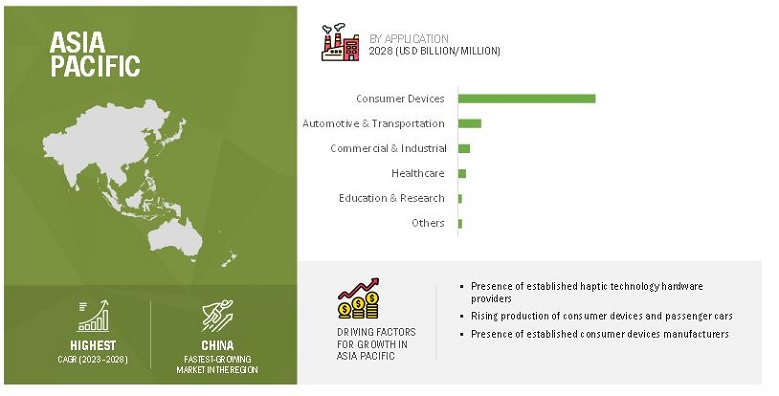
Haptic Technology Market by Region
To know about the assumptions considered for the study, download the pdf brochure
Key Market Players
The major players in the haptic technology companies include Texas Instruments Incorporated (US), Johnson Electric Holdings Limited (China), AAC Technologies (China), TDK Corporation (Japan), and Microchip Technology Inc. (US). These companies have used both organic and inorganic growth strategies such as product launches, acquisitions, and partnerships to strengthen their position in the market.
Haptic Technology Market Report Scope
|
Report Metric |
Details |
|
Estimated Market Size |
USD 3.9 billion in 2022 |
|
Projected Market Size |
USD 5.0 billion by 2028 |
|
Growth Rate |
CAGR of 3.7% |
|
Market size available for years |
2019–2028 |
|
Base year considered |
2022 |
|
Forecast period |
2023–2028 |
|
Forecast units |
Value (USD Million/Billion), Volume (Million/Billion Units) |
|
Segments covered |
By Component, Application, Feedback Type, and Region |
|
Geographies covered |
North America, Europe, Asia Pacific, and Rest of the World (RoW) |
|
Companies covered |
The major players in the haptic technology market are Texas Instruments Incorporated (US), Johnson Electric Holdings Limited (China), AAC Technologies (China), TDK Corporation (Japan), Microchip Technology Inc. (US), Immersion (US), Semiconductor Components Industries, LLC (US), Precision Microdrives (UK), Synaptics Incorporated (US), and ultraleap (UK). |
Haptic Technology Market Highlights
The study segments the haptic technology market based on component, application, feedback type, and region at the regional and global level.
|
Segment |
Subsegment |
|
By component |
|
|
By Application |
|
|
By Feedback Type |
|
|
By Region |
|
Recent Developments in HapticTechnology industry
- In January 2023, TDK Corporation announced the TDK i3 Micro Module, which has a built-in edge AI and wireless mesh connectivity capability. Through TDK’s collaboration with Texas Instruments (TI), the i3 Micro Module integrates the TI SimpleLink platform, featuring the CC2652R7, an Arm Cortex-M4F multiprotocol 2.4-GHz wireless 32-bit microcontroller (MCU) for real-time monitoring.
- In November 2022, Texas Instruments Incorporated announced the development of new Matter-enabled software development kits for Wi-Fi and Thread SimpleLink wireless microcontrollers (MCUs), CC3235SF and CC2652R7, which will streamline the adoption of the Matter protocol in the Internet of Things (IoT) applications.
- In June 2022, Microchip Technology Inc. launched maXTouch Knob-on-Display (KoD), an automotive-grade touchscreen controller that facilitates the detection and reporting of capacitive rotary encoders and mechanical switches on a touch panel.
- In October 2021, AAC Technologies announced its joint venture with OnePlus for OnePlus 9RT, SLS ultra-linear speaker with an NLC low-frequency algorithm and X-axis linear motor with RichTap tactile feedback.
- In September 2020, Johnson Electric Holdings Limited announced the launch of a new addition to the professional line of hair dryer motor solutions. The ECI-050 brushless motor for hair dryers is a single-phase solution that offers better performance while being cost-effective.
Frequently Asked Questions (FAQ):
What is the current size of the global haptic technology market?
The haptic technology market is estimated to be worth USD 4.2 billion in 2023 and is projected to reach USD 5.0 billion by 2028, at a CAGR of 3.7% during the forecast period.
Who are the winners in the global haptic technology market?
Companies such as Texas Instruments Incorporated (US), Johnson Electric Holdings Limited (China), AAC Technologies (China), TDK Corporation (Japan), and Microchip Technology Inc. (US), fall under the winners category.
Which region is expected to hold the highest market share?
Asia Pacific is expected to dominate the haptic technology market during forecast period. Growing production of cars and consumer devices and the presence of established haptic technology component providers are the major factors contributing to the market growth in Asia Pacific.
What are the major drivers and opportunities related to the haptic technology market?
Rising deployment of haptic technology into consumer devices, increasing usage of haptics in automotive industry and technological advancements related to haptics are some of the major drivers and opportunities related to the haptic technology market.
What are the major strategies adopted by market players?
The key players have adopted product launches, acquisitions, and partnerships to strengthen their position in the haptic technology market.
To speak to our analyst for a discussion on the above findings, click Speak to Analyst
The research study involved 4 major activities in estimating the size of the Haptic technology market. Exhaustive secondary research has been done to collect important information about the market and peer markets. The validation of these findings, assumptions, and sizing with the help of primary research with industry experts across the value chain has been the next step. Both top-down and bottom-up approaches have been used to estimate the market size. Post which the market breakdown and data triangulation have been adopted to estimate the market sizes of segments and sub-segments.
Secondary Research
In the secondary research process, various secondary sources were referred to for identifying and collecting information required for this study. The secondary sources include annual reports, press releases, and investor presentations of companies, white papers, and articles from recognized authors. Secondary research was mainly done to obtain key information about the market’s value chain, the pool of key market players, market segmentation according to industry trends, and regional outlook and developments from both market and technology perspectives.
Primary Research
In the primary research, various primary sources from both supply and demand sides were interviewed to obtain qualitative and quantitative insights required for this report. Primary sources from the supply side include experts such as CEOs, vice presidents, marketing directors, equipment manufacturers, technology and innovation directors, end users, and related executives from multiple key companies and organizations operating in the haptic technology market ecosystem.
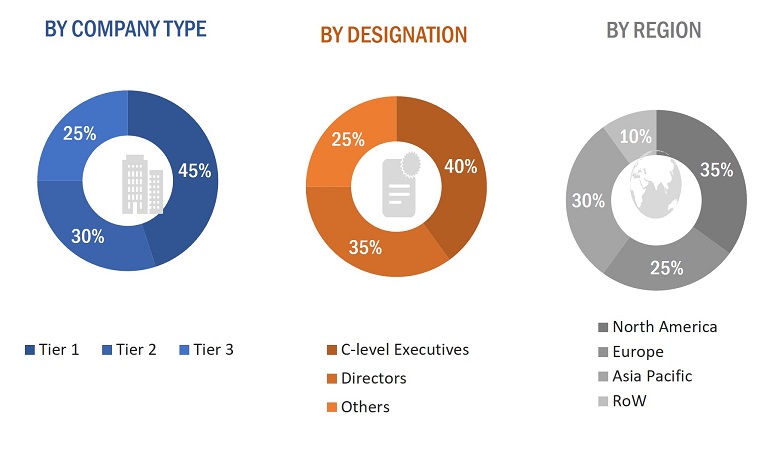
To know about the assumptions considered for the study, download the pdf brochure
Market Size Estimation
In the market engineering process, both top-down and bottom-up approaches along with data triangulation methods have been used to estimate and validate the size of the haptic technology market and other dependent submarkets. The research methodology used to estimate the market sizes includes the following:
- Initially, MarketsandMarkets focuses on top-line investments and spending in the ecosystem. Further, the segment-level splits and major developments in the market have been considered.
- Identifying stakeholders in the haptic technology market that influence the entire market, along with participants across the value chain.
- Analyzing major hardware and software providers as well as studying their product portfolios
- Analyzing trends related to the adoption of haptic components based on application
- Tracking the recent and upcoming developments in the market that include investments, R&D activities, product launches, collaborations, mergers & acquisitions, and partnerships, as well as forecasting the market size based on these developments and other critical parameters
- Conducting multiple discussions with key opinion leaders to identify the adoption trends of haptic components
- Segmenting the overall market into various other market segments
- Validating the estimates at every level through discussions with key opinion leaders, such as chief executives (CXOs), directors, and operation managers, and finally with the domain experts at MarketsandMarkets
Market Size Estimation Methodology-Bottom-up Approach

Data Triangulation
After arriving at the overall market size through the process explained above, the overall market has been split into several segments. Wherever applicable, the market breakdown and data triangulation procedures have been employed to complete the overall market engineering process and arrive at the exact statistics for all the segments. The data has been triangulated by studying various factors and trends from both the demand and supply sides. The market has also been validated using both the top-down and bottom-up approaches
Market Definition
According to the American Library Association, haptic technology, haptic feedback, or simply haptics, can be defined as a technology that incorporates tactile experience or feedback as a part of its user interface, creating a sense of touch through vibrations, motion, or other forces.
Stakeholders
- Haptic component manufacturers
- Haptic software providers
- Raw material and manufacturing equipment suppliers
- Haptic technology market technical consultants
- Technology standards organizations, forums, alliances, and associations
- Governments, financial institutions, and investment communities
- Research organizations
- Analysts and strategic business planners
- Venture capitalists, private equity firms, and startups
- Distributors
The main objectives of this study are as follows:
- To describe and forecast the haptic technology market, in terms of value, by component, feedback type, and application
- To describe and forecast the market, in terms of value, by region—North America, Europe, Asia Pacific, and the Rest of the World (RoW)
- To provide detailed information regarding major factors influencing the market growth (drivers, restraints, opportunities, and challenges)
- To provide a detailed overview of the value chain pertaining to the haptic technology ecosystem, along with the average selling price trends
- To strategically analyze the ecosystem, patent landscape, and various case studies pertaining to the haptic technology market.
- To strategically analyze micromarkets regarding individual growth trends, prospects, and contributions to the total market
- To strategically profile key players and comprehensively analyze their market position in terms of ranking and core competencies, along with detailing the competitive landscape for market leaders
- To analyze strategic approaches such as product launches, collaborations, contracts, agreements, partnerships, acquisitions, and joint ventures in the haptic technology market
Available Customizations:
With the given market data, MarketsandMarkets offers customizations according to the specific requirements of companies. The following customization options are available for the report:
Country-wise Information:
- Analysis for additional countries (up to five)
Company Information:
- Detailed analysis and profiling of additional market players (up to five)



 Generating Response ...
Generating Response ...







Growth opportunities and latent adjacency in Haptic Technology Market
Our company is a major player in the Haptics technology market and we would like to be included into your next report. Please contact me so I can inform you about our technology and markets.
I want data about haptic technology on laptop. I want to know whether laptops with haptic technology are increasing.
Hello, I'm considering purchasing this haptics report, however, I have a few basic questions. When you estimate the value of the haptic market (current and future), what does that valuation mean? It appears to be based off sales, but what / whose sales? What are the metrics or components of that number?
I am working on new tele-haptic technologies (devices and systems) together with my research team. I would like to get your market analysis report which will be valuable to forecast this field near future. I would also like to keep contacting with you for potential collaboration with you. Thank you very much.
I'm interested in this market and where it's headed. Looking for a good view of that.
We are doing some research about haptic technology and we would like to ask for a sample of your report.
Need information on the market dynamics and size among major Haptics players including the joint development, agreements, partnership, etc.
Need information on regional segment forecast. I saw the circle charts in the preview.
I'm curious how you calculate total Haptic Market. What segments it is composed of?
We are interested in haptic (Tactile) feedback given to the user in healthcare applications specifically.
Hello, I am particularly interested in some solutions proposed on the market, and mainly high level market data to understand how big is this market and is there a potential for polystyrene products.
I'm writing a story for Medium's new science and tech vertical about the future of haptic and other technologies. Do you offer press copies of these reports?
I'd like to get clarification on what is meant by haptic. Does this report only look at touchscreens that produce some type of physical feedback, e.g. vibration, when touched?
Realizing my PhD in haptic technology, this document will illustrate the industrial interest in this field of technology.